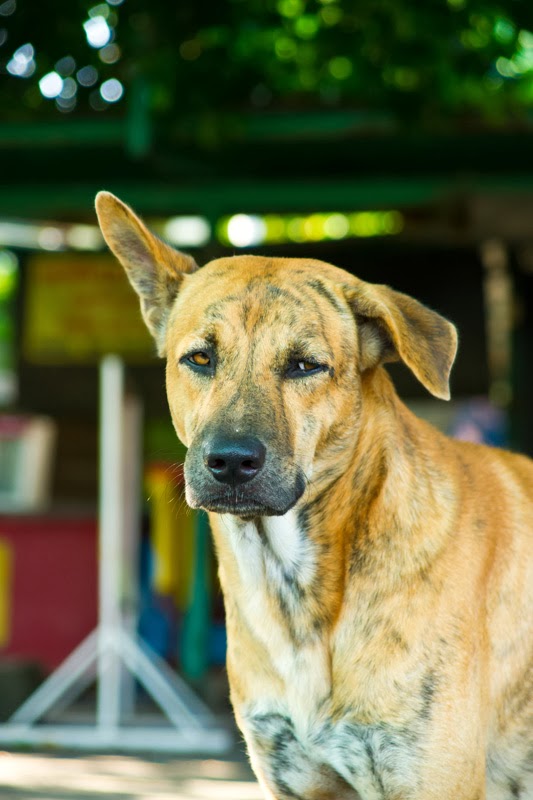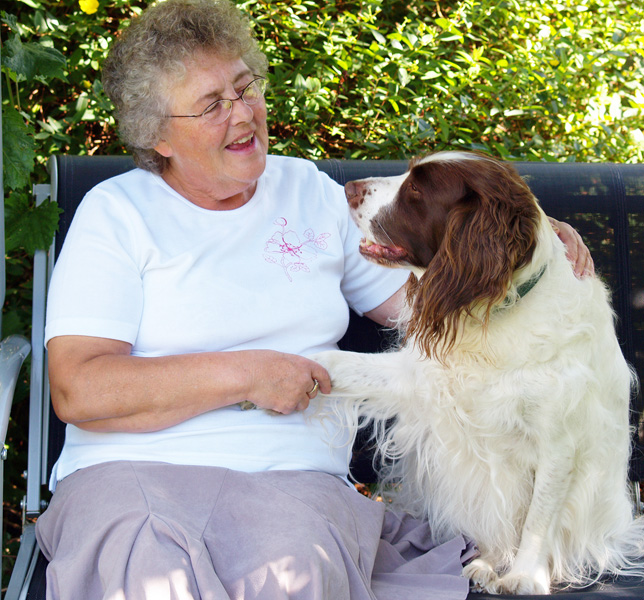If you’ve ever been to Bangkok, you will have noticed stray dogs and cats loitering on the street corners. Some are well fed, but many are scrawny, flea-ridden, and have old injuries. While many sleep away the day, others are tricky for pedestrians to navigate. New research by Nikki Savvides investigates the relationship between people and street dogs in the capital of Thailand.
 |
| Photo: Krisdayod / Shutterstock |
Thai people’s attitudes to animals are shaped by Theravada Buddhism, including a belief that killing animals is wrong. Although most Thai people eat meat and fish, there is a vegetarian festival in the month of October, when for ten days people ‘
gin jeh’ (eat vegetarian). There are spirit housesoutside most buildings, where Thai people light incense and make offerings of flowers, food and other items. Acts of kindness towards animals, such as feeding strays or releasing birds from cages, are a way to ‘make merit’ (
tam bon) for the next life. Stray dogs and cats are sometimes taken to Buddhist temples where the monks will feed them.
Estimates of the number of stray dogs in Bangkok range from 100,000 to 300,000. In 2007, the Bangkok Metropolitan Authority brought in regulations requiring pet dogs to be registered, micro-chipped and vaccinated against rabies. Clinics offer free chips and vaccinations, although it is not clear what effect this has had on strays. Some stray dogs are sent to a facility in Uthai Thani, which has space for 8,000 dogs and is always full.
Savvides’ research is based on two weeks as a volunteer for Soi Cats and Dogs in 2008, and three subsequent visits to Thailand. SCAD was a Western-run organization that aimed to improve the welfare of soi dogs and cats. Savvides reports that it ceased operations in 2012 due to a lack of funding (in fact it became part of the Soi Dog Foundation, see later). Some of the dogs that SCAD cared for were adopted into new homes, mainly by Westerners, but the vast majority were treated for veterinary ailments, spayed/neutered and returned to the streets.
Savvides says the descriptions of dogs that might be adopted were anthropocentric, giving them names and writing about their history and personality so they were no longer anonymous soi [street] dogs. Before and after photographs show “the transformation of soi dogs from monstrous-looking creatures devoid of hair and muscle tone to sleek, well-cared for animals.”
The paper says that although 20% of people in Bangkok own pet dogs, they do not seem to want to adopt soi dogs. She gives several reasons for this, including their generally poor state of health, lack of training, and sometimes fearsome behaviour on the streets. In addition there is a fear of rabies. Although rabies is not as common in Bangkok as in some other parts of Thailand, it does occur. For example, in 2010 the owner of a pet stall at Chatuchak Market died of rabies after contracting it from one of the puppies she had for sale and in 2012, a rabid rabbit was sold at the same market.
As part of her volunteer work, Savvides helped with a stall for the charity at a pet show at an expensive shopping centre. As well as pet food and basic accessories, many luxuries were for sale including Swarovski crystal jewellery for dogs, designer haircuts and pet portraits. In this place of conspicuous consumption, the soi dogs seemed out of context.
Savvides also writes about what she calls ‘community dogs’, stray dogs that are looked after to a greater or lesser extent by people who live in the neighbourhood. Working people eat at street stalls on their way home, and often give some of their food to the dogs. Many people buy food specifically for the dogs that live on their soi. This might be because they feel sorry for or fond of the animals, but is also a way to ‘make merit’. Savvides says that at Siriraj Hospital, visitors will feed the stray dogs in the hope that if they make merit like this, their family member’s health will improve.
She says, “On each trip I ate dinner most nights at one of Bangkok’s many food markets, which were always home to a number of soi dogs. I observed market stall owners feeding dogs scraps, mainly rice but sometimes fish heads and off-cuts of meat. Women and men selling noodles, soups, and fried chicken at the markets put out bowls full of food on the streets every evening. Some hand fed the animals. I saw people tending to soi puppies, ensuring that they could eat without being bothered by larger dogs.”
Although Savvides believes these cultural practices are specific to Bangkok, I have seen similar interactions with soi dogs in other parts of Thailand.
The Soi Dog Foundation has sterilized over 60,000 cats and dogs since it was founded on Phuket in 2003. Although some dogs live at the shelter and can be sponsored or adopted, most are spayed/neutered, treated for veterinary conditions and returned to the street. The SDF says that “killing animals or rounding them up and placing them in dog pounds has no effect whatsoever on the overall population, as the fertile remainder will always rapidly breed to fill the void. It has been scientifically proven that spaying and neutering 75% to 80% of a population of a species will see a reduction in numbers.”
This reasoning is similar to that used by Trap, Neuter and Return groups for feral cats in Western countries, but here is applied to dogs as well as cats.
Savvides believes that scholars have been too focussed on the relationship between people and dogs that live in the home. She says, “Western theory on human-dog relationships has shaped a narrative for dog-keeping practices in which the animal lives in an individualised, pseudo-familial relationship with the human in the home.” This seems to ignore research on working dogs and shelter dogs, as well as the interest in domestication, and the street dogs of Moscow, for example, although it is certainly true there is still much to learn about the human-animal bond.
She also says, “No doubt there are a myriad of practices currently in existence in different cultures that defy any current understandings of human-dog relationships. Those between humans and soi dogs in Bangkok are one such example.”
 |
| Photo copyright Graeme Oldham |
I was especially interested to read this paper since I used to live in Bangkok. The photograph shows a dog called Judy in the Sathorn area. As you can tell from the collar, she is an owned dog. During the day, she would wander out of her property to visit the street stalls set up on the sidewalk. She was unperturbed by the crush of children coming out of the nearby school in the afternoon. I often saw her being given bits of hot dog and other food by the vendors.
Thinking about the community where you live, do you notice differences in the ways people live and interact with dogs?
Reference
Savvides, N. (2013). Living with Dogs: Alternative animal practices in Bangkok,, Thailand Animal Studies Journal, 2 (2), 28-50. Available with open access at http://ro.uow.edu.au/asj/vol2/iss2/3/




